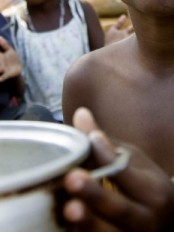|
||||||||||||||||||
|
|
Haiti - Social : Food security, humanitarian aid insufficient 04/04/2013 11:03:47
The World Food Program’s "Supplementary Feeding Programme", for example, has fed some 685,000 students and 145,000 pregnant and lactating women and children under 5 years. In addition to response to the passage of Sandy, the "Take home ration" provided food to 200,000 people over a period of 15 days. USD 5.2 million was set aside to fund "work for money" programs in areas affected by the passage of Sandy and in other vulnerable zones. The Government of Haiti (GoH), through Fund of Economic and Social Assistance (FAES), a public body for social security, has distributed 138,402 food packages worth about USD 5 million. The United States Agency for International Development (USAID), on its part, has funded projects totaling USD 15 million covering food distribution, cash transfers to the needy and infrastructure repair. According to the National Coordination for Food Security (CNSA), Hurricane Sandy food assistance has reached about 700 000 people. However, the aid falls below the real needs of the affected. The situation is dire in 30 communes in six departments (especially Southeast, Plateau Central, Southern peninsula, Northwest, West and Artibonite) and requires continued assistance to prevent the affected from falling in to Phase 4 of the Integrated Food Security Phase Classification (IPC), which is equivalent to a humanitarian emergency. Integrated Food Security Phase Classification (IPC) Phase 1 : Usually adequate and stable food access with moderate to low risk of sliding into Phase 3, 4, or 5. Phase 2 : Moderately / Borderline Food Insecure Borderline adequate food access with recurrent high risk (due to probable hazard events and high vulnerability) of sliding into Phase 3, 4, or 5. Phase 3 : Acute Food and Livelihood Crisis Highly stressed and critical lack of food access with high and above usual malnutrition and accelerated depletion of livelihood assets that, if continued, will slide the population into Phase 4 or 5 and / or likely result in chronic poverty. Phase 4 : Humanitarian Emergency Severe lack of food access with excess mortality, very high and increasing malnutrition, and irreversible livelihood asset stripping. Phase 5 : Famine / Humanitarian Catastrophe Extreme social upheaval with complete lack of food access and / or other basic needs where mass starvation, death, and displacement are evident According to WFP, the current lean season up to 145,000 persons in acute livelihood crisis may require food aid until crop harvests in June and July. An increase in acute malnutrition, as measured by brachial perimeter (BP), has been recorded in vulnerable areas since October 2012. The situation is of great concern particularly in Moron (Grand Anse) where the number of cases of malnutrition have almost doubled from 2.1 to 4.0% between December 2012 and January 2013. Humanitarian intervent ions have helped to contain acute malnutrition in the Troisieme Section Calumette and the Baie d’Orange in the Southeast. WFP is concerned about the lack of funds for pre-positioning stocks in four areas where WFP is based (Gonaives, Port-au-Prince, Jacmel, Cap-Haitien), ahead of the rainy and hurricane seasons. Other major challenges, including logistical requirements relating to transport fleets, human resources and rent, may undermine rapid and efficient response. The new funding component "Food Security and Nutrition" in the Humanitarian Action Plan 2013, totaling USD 4.4 million, will provide the needy with a better response and enable the mitigation of food insecurity and acute malnutrition mainly in children under 5 years. However, there is an urgent need for continued advocacy for resource mobilization and work with the Haitian government to carry out joint actions, WFP stresses. Key figures 6,7 millions of people suffering from food insecurity in Haiti (4.1 million in rural areas and 2.6 million in urban areas); 5,2 million in moderate food insecurity ; 1,5 million in severe food insecurity (792.758 women and 731.601 men) ; 81,600 children under 5 suffer from malnutrition whose 61.200 children of moderate malnutrition and 20,400 of acute malnutrition. HL/ HaitiLibre
|
|
|
Why HaitiLibre ? |
Contact us |
Français
Copyright © 2010 - 2024 Haitilibre.com |



